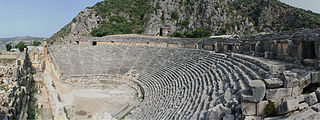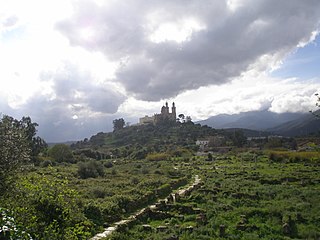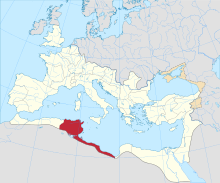
Myra was an ancient Greek, then Roman Greek, then Byzantine Greek, then Ottoman Greek town in Lycia, which became the small Turkish town of Kale, renamed Demre in 2005, in the present-day Antalya Province of Turkey. In 1923 its Greek inhabitants had been required to leave by the Population exchange between Greece and Turkey, at which time its church was finally abandoned. It was founded on the river Myros, in the fertile alluvial plain between Alaca Dağ, the Massikytos range and the Aegean Sea.

Hippo Regius is the ancient name of the modern city of Annaba, in Algeria. Hippo Regius was a Phoenician, Berber, and Roman city in present-day Annaba Province, Algeria. It was the locus of several early Christian councils and home to the philosopher and theologian Augustine of Hippo.

Parthenia was a Roman–Berber town in the former Roman province of Mauretania Sitifensis, the easternmost part of ancient Mauretania. It was located in what is now northern Algeria.

Batroun is a coastal city in northern Lebanon and one of the oldest cities in the world. It is the capital city of Batroun District.
A titular bishop in various churches is a bishop who is not in charge of a diocese. By definition, a bishop is an "overseer" of a community of the faithful, so when a priest is ordained a bishop, the tradition of the Roman Catholic and Orthodox churches is that he be ordained for a specific place. There are more bishops than there are functioning dioceses. Therefore, a priest appointed not to head a diocese as its diocesan bishop but to be an auxiliary bishop, a papal diplomat, or an official of the Roman Curia is appointed to a titular see.
Irenopolis was an ancient and medieval city in Roman and Byzantine era Isauria.

Barca, also called Barce, was an ancient city and former bishopric, which survives as both a Latin Catholic and an Orthodox titular see.

The Bishop of Limerick is an episcopal title which takes its name after the city of Limerick in the Province of Munster, Ireland. In the Roman Catholic Church it still continues as a separate title, but in the Church of Ireland it has been united with other bishoprics.

The Roman Catholic Diocese of Baguio is a Latin Rite suffragan diocese in the ecclesiastical province of the Metropolitan Archdiocese of Nueva Segovia on Luzon island in the Philippines.

The Western world, also known as the West, refers to various nations depending on the context, most often including at least part of Europe, Australasia, and the Americas, with the status of Latin America in dispute. There are many accepted definitions, all closely interrelated. The Western world is also known as the Occident, in contrast to the Orient, or Eastern world.

Mesarfelta was a Roman–Berber town in the province of Numidia. It was also a bishopric that is included in the Catholic Church's list of titular sees.
Jebiniana is a town and commune in the Sfax Governorate, Tunisia.

Kalâa Kebira is a town and commune in the Sousse Governorate, Tunisia. As of 2004 it had a population of 45,990.
Sidi El Hani is a town and commune in the Sousse Governorate, Tunisia located at 35.67n, 10.30e. As of 2004 it had a population of 3,058. It gives its name to the largest lake of the governorate, a natural salt lake or salt pan (sabkha) in dry seasons, the Sebkhet de Sidi El Hani which is shared with between one and two other areas depending on precipitation and its maximum extent forms the official boundary with part of a third, Monastir Governorate. The town is 30km south-west of the coast, its straightest connection being by Tunisian Railways, with a secondary connection by road, the P12 road which is a principal road to Kairouan from the A1 a few kilometres to the east. it is 19km from Kairouan and 26 km from Raqqada and.

Damanhur is a city in Lower Egypt, and the capital of the Beheira Governorate. It is located 160 km (99 mi) northwest of Cairo, and 70 km (43 mi) E.S.E. of Alexandria, in the middle of the western Nile Delta.

Blaundus was a Roman episcopal city in Asia Minor, presently Anatolia, and is now a Latin Catholic titular bishopric.

Apollonos Hieron was an ancient city of Lydia.

Vescera, also known as Ad Piscinam, was an ancient titular see and Roman colony in Roman North Africa. It has been identified as a site near Biskra in Algeria. It remains as a titular see of the Roman Catholic Church in the Province of Numidia.
Apollonis , also known as Apollonia (Ἀπολλωνία), Apollones (Ἀπολλώνης), and Apollonias (Ἀπολλωνίας), was a city in ancient Lydia. It was located south of Apollonia in Mysia, where there is a ridge of hills, after crossing which the road to Sardis had on the left Thyatira, and on the right Apollonis, which was 300 stadia from Pergamum, and the same distance from Sardis. It was named after the queen Apollonis, the mother of Eumenes II and Attalus II of Pergamum, in the place of an older city; possibly Doidye. It was mentioned by Cicero. It was destroyed in 17 CE by the great earthquake that destroyed twelve cities of Asia Minor. Tiberius rebuilt the city. It issued coins; those from Marcus Aurelius to Severus Alexander are extant. Apollonis is a titular see of the Roman Catholic Church.


















